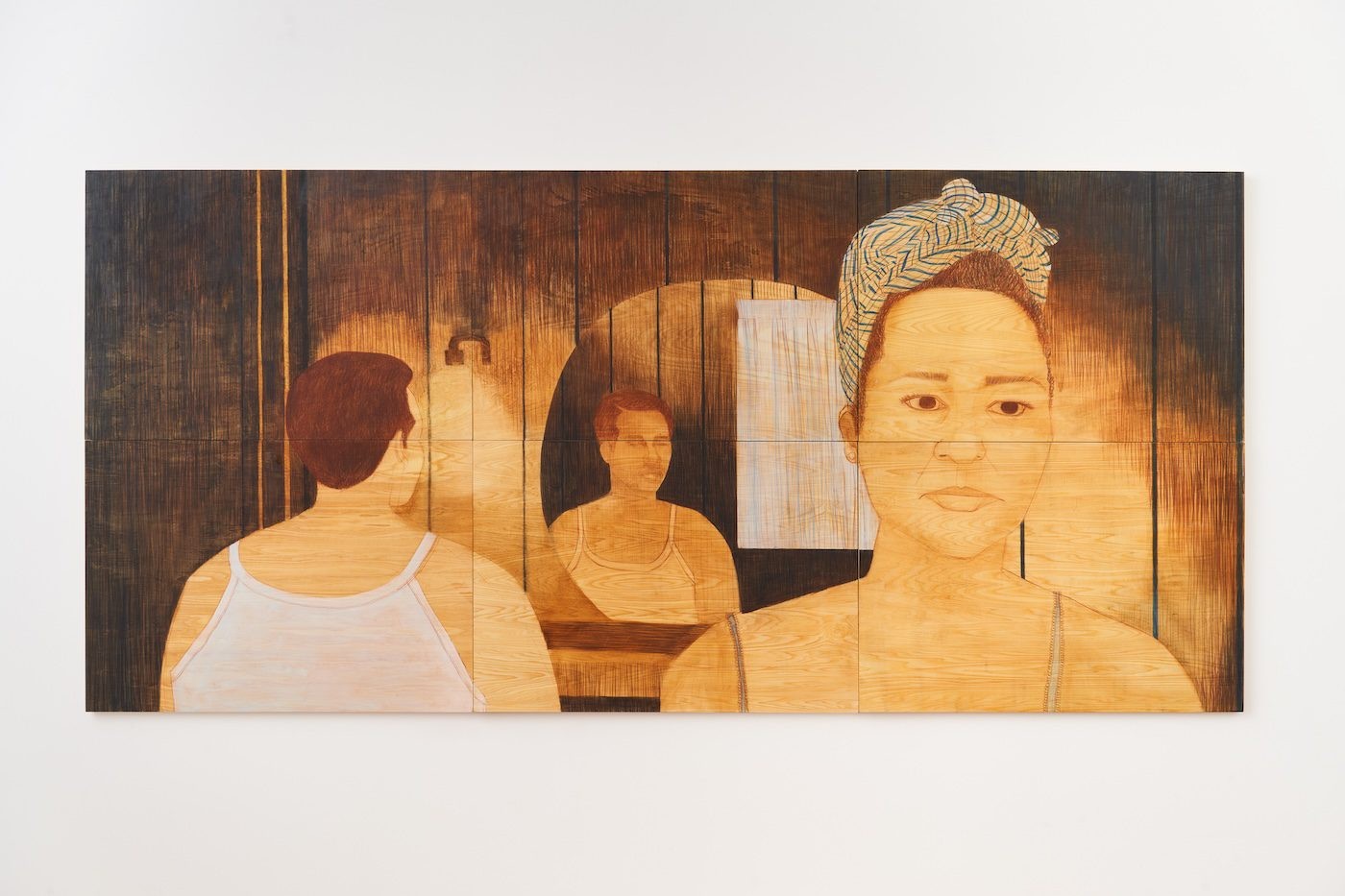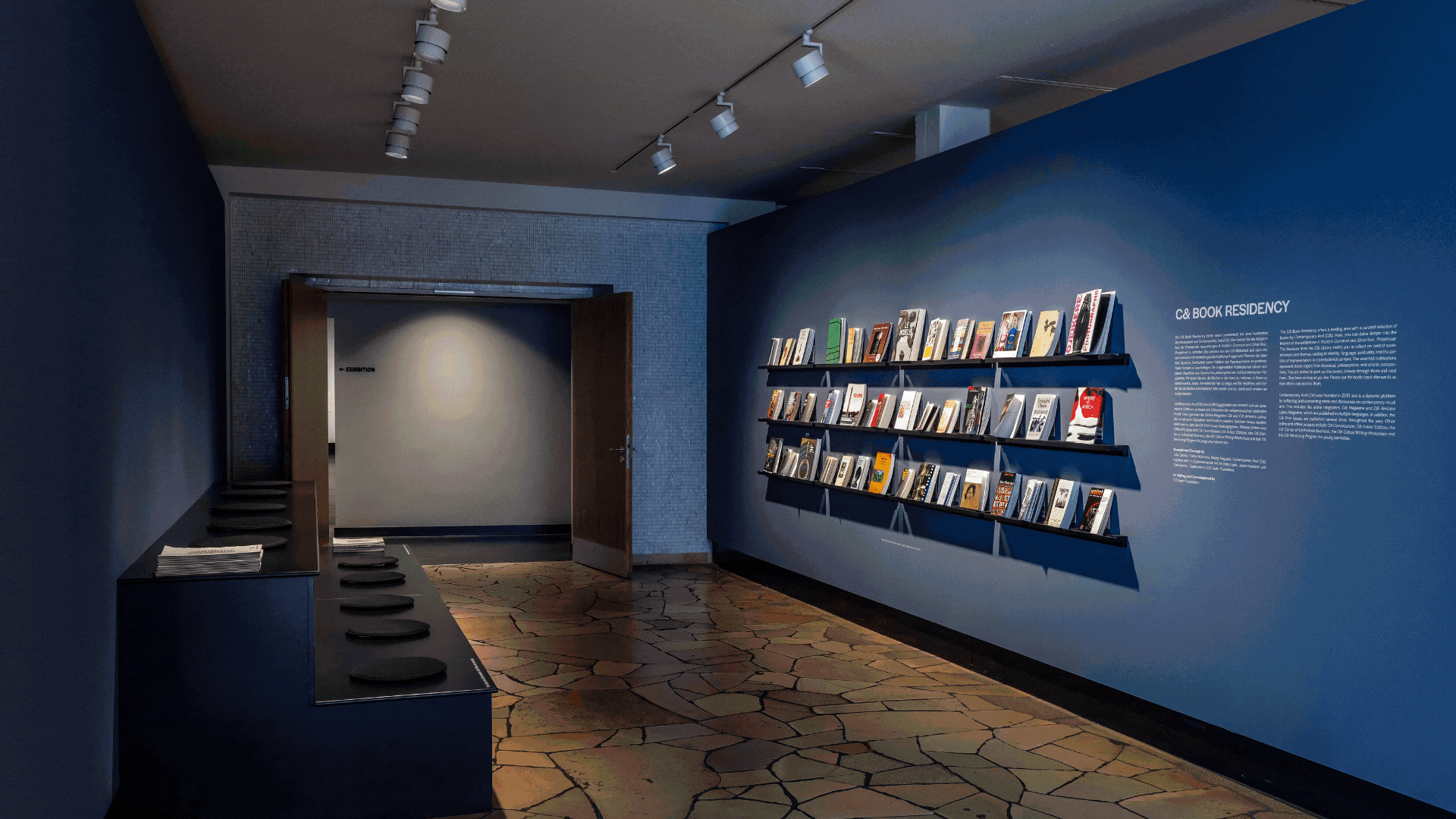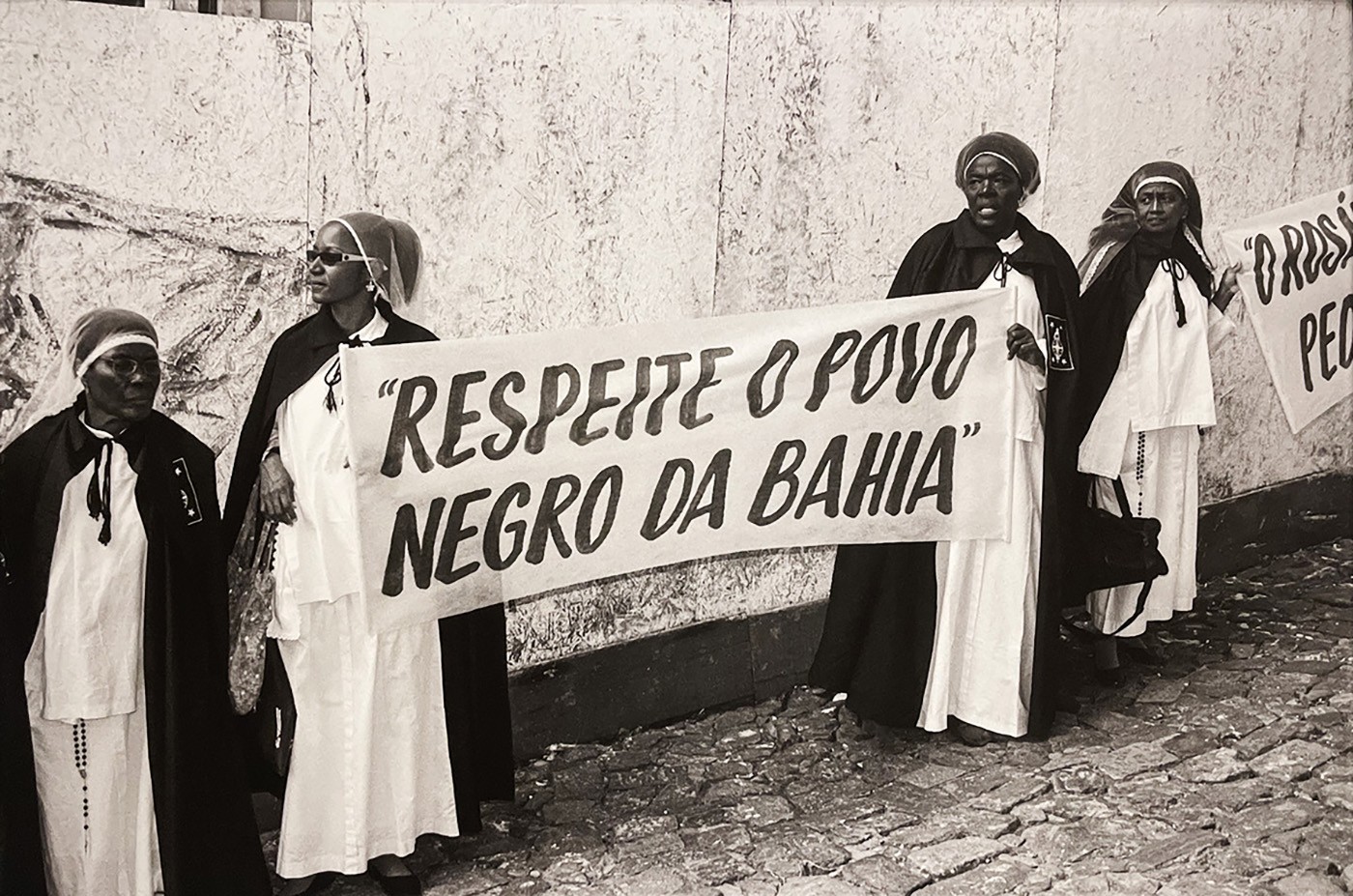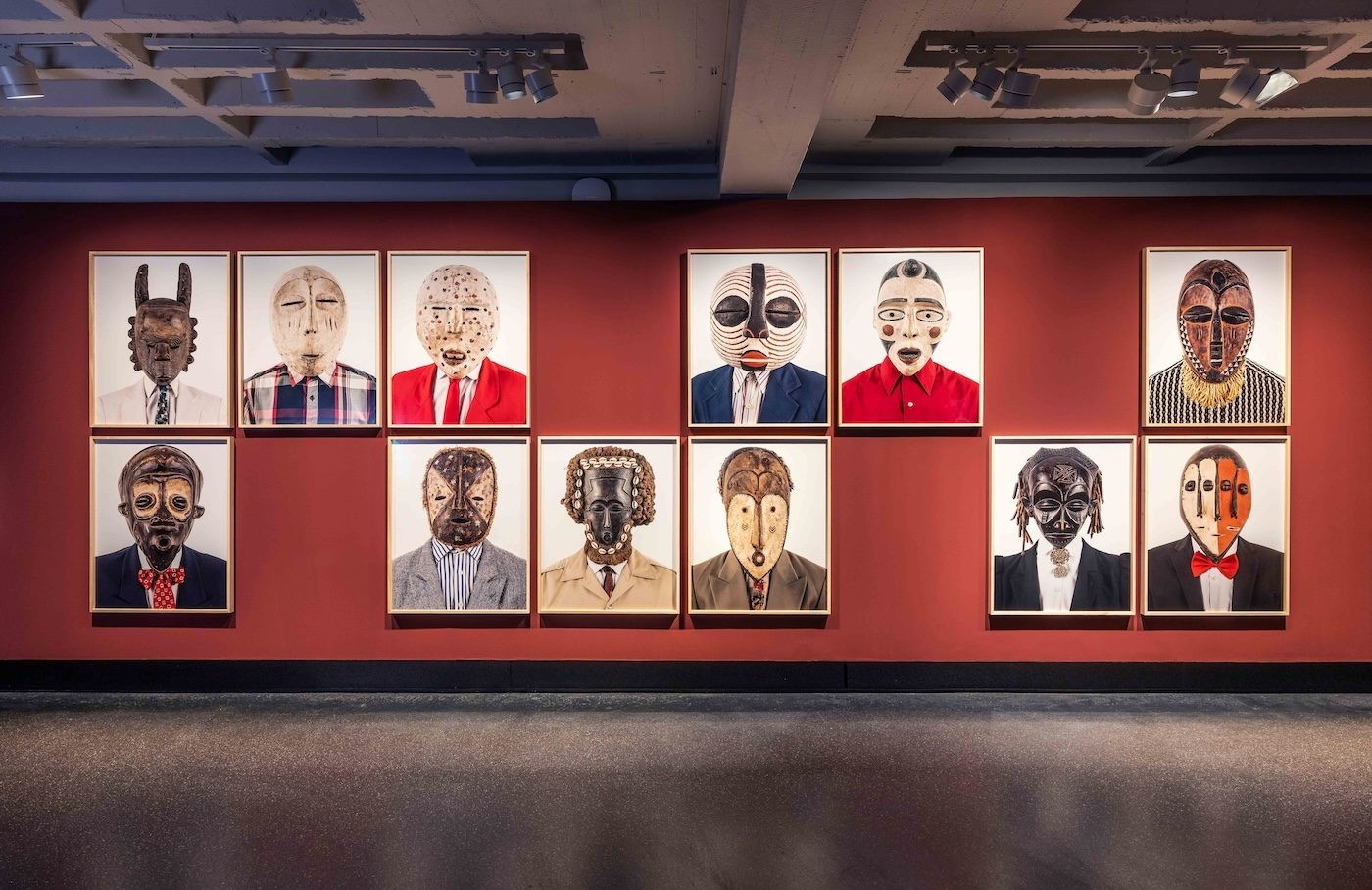Pamela Phatsimo Sunstrum: A Dramatic Painted Mystery Investigates Ideas about Women’s Power

09 October 2024
Magazine C& Magazine
Words Sabo Kpade
7 min read
The painter discusses It Will All End in Tears, her site-specific installation at London’s Barbican Center, made with architect Remco Osório Lobato.
Sabo Kpade: You have been making site-specific drawings on walls as far back as 2009 or prior. What specifically was exciting about the Curve Commission at the Barbican Center?
Pamela Phatsimo Sunstrum: What really inspired me when I was first invited and started walking through the space was the Barbican as a complex, really – that it stood as this mighty symbol of Western European cultural aspirations. My imagination is always sparked by these fascinating projects of the empire. How they rise, but more than that by how they fall and what they represent. And then very quickly, specifically, I became really interested in cinema and theater, which is a big part of the Barbican's programming. I had already been thinking about and making reference to the cinematic in my work – to characters and to drama and to the way that film and theater construct or compose an image. This was really the starting place.

Pamela Phatsimo Sunstrum: It Will End in Tears. Installation view Barbican Art Gallery 19 September 2024 – 5 January 2025 © Jo Underhill / Barbican Art Gallery.
SK: What is the core narrative in It Will All End in Tears?
PPS: It comes out of somewhat misogynistic ideas about women and how women's power can manifest. The story is about a woman called Bettina (a reference to South African writer Bessie Head) who returns home to a colonial outpost in Botswana of the mid-twentieth century. Since she left this place and went on into the world, she's changed quite a lot. I think for those of us who grow up with some connection to the African Diaspora, that feeling of being away, having had an education or an exposure to other cultures, and then coming back home is quite a fraught one. There's often this tension between who you've been sent out into the world to become, what you've been expected to bring back, and how that can become a conflict. So when Bettina comes back home, she's met with the usual things: suspicion, jealousy, desire. And in this mix emerges a crime, a criminal mystery. There's a little bit of lust, a little bit of violence.

Pamela Phatsimo Sunstrum: It Will End in Tears. Installation view Barbican Art Gallery 19 September 2024 – 5 January 2025 © Jo Underhill / Barbican Art Gallery
SK: What films and stage plays influenced your research?
PPS: The first one was Streetcar Named Desire (1951), directed by Elia Kazan and based on the play by US playwright Tennessee Williams. Kazan plays on our expectations brilliantly. I looked closely at several Alfred Hitchcock films – mainly Rear Window (1954), in which there is a constant shifting based on your perspective, as is common in Hitchcock films. A more contemporary film is Lars von Trier's Dogville (1999). In many ways I despise him as a director because of what he does to women's bodies and women's stories, but I found Dogville fascinating because it’s really playing with sets and set design. The whole film was shot on a bare lot.

Pamela Phatsimo Sunstrum: It Will End in Tears. Installation view Barbican Art Gallery 19 September 2024 – 5 January 2025 © Jo Underhill / Barbican Art Gallery.
SK: One feature of It Will All End in Tears is how controlled and essentialized the scenes in the painting are. There are no children, pets or, other features of rural domestic life.
PPS: I'm really pushing into this idea of a set, especially a theatrical set. So it almost looks like we're not looking at a real house, we're looking at the façade of a house and the strangely unnatural way that all of these characters have converged on this dramatic moment. It's like a tableau. I was intentional about leaning on drama, on how as an audience member of a play or film we get to see everything and all at once. I tried to make the palette and everything else a little bit subtle or subdued, in order to slow you down and make you go into the details.

Pamela Phatsimo Sunstrum: It Will End in Tears. Work in progress (detail) in Pamela Phatsimo Sunstrum's studio, The Hague, Netherlands, 2024. Courtesy the artist and Goodman Gallery. Photo: Lotte van Uitterst.
SK: Why have you chosen to paint on wood panels?
PPS: I love working modularly on these beautiful panels because they break down into crate-sized containers that can safely and efficiently and sustainably be moved around the world, unlike big unwieldy paintings. There are a lot of variables working on wood. You can't predict the grain. And you can't predict what will happen once you start oiling the grain because it starts to get its own life, and you start to see things that you didn’t see before. I spend a lot of time being a little mesmerized by what happens with wood grain, which I can't really take credit for.

Pamela Phatsimo Sunstrum: It Will End in Tears, SCENE 19, 2024. Courtesy Pamela Phatsimo Sunstrum and Goodman Gallery. Photo: Alexander Edwards.
SK: Are the flora in the paintings imagined or true to the foliage in Botswana? What is their significance?
PPS: That's a good question. I would say no. I didn't select specific foliage. But yes, you would see all of these grasses and shrubs and flowers in my grandmother's back garden. More so what I was curious about is how there's a lot of care put into gardening in your little domestic space in environments where water is scarce or plants are scarce. I wanted the foliage to emphasize the frame, as if we are almost spying on this person in their domestic space. I wanted to remind the viewer that they are a bit of an outsider to this woman's internal space.

Pamela Phatsimo Sunstrum: It Will End in Tears. Works in progress in Pamela Phatsimo Sunstrum's studio, The Hague, Netherlands, 2024. Courtesy the artist and Goodman Gallery. Photo: Lotte van Uitterst.
SK: You typically don’t make preparatory drawings. Was that the case for this exhibition?
PPS: So I did preparatory sketches for the first time. I felt I was storyboarding like a real filmmaker. I made these scenes and edited them and reframed them and figured out which ones I actually needed. From over sixty preparatory drawings, I then had to really edit down to the show, which ended up being nineteen paintings. As a result, I feel that there's a lot more clarity in the grouping of the work. So maybe this is a new thing that I'll be doing. In October 2024 we'll be showing the full range of the preparatory sketches at Goodman Gallery.
Pamela Phatsimo Sunstrum: It Will End In Tearson view from 19 September 2024 to 5 January 2025 at The Curve, Barbican, London, UK.
Pamela Phatsimo Sunstrum’s (b. 1980, Mochudi, Botswana) work includes imagery that reflects the diverse genealogies of her experience living in different parts of Africa, Southeast Asia, and the U.S. as well as ongoing research in ethnography, ecology, and quantum physics. The artist’s boundary-crossing practice centers Black female identity in the discourse of postcolonialism and neocolonialism, highlighting the contributions of overlooked historical figures while emphasizing modes of knowledge and communication beyond the status quo. @pamelaphatsimo / pamelaphatsimosunstrum.com
</em>
Sabo Kpade is a culture writer from London.
Read more from

C& Highlights of 2025

Maktaba Room: Annotations on Art, Design, and Diasporic Knowledge

Irmandade Vilanismo: Bringing Poetry of the Periphery into the Bienal
Read more from

Cabo Verde’s Layered Temporalities Emerge in the Work of César Schofield Cardoso

What’s Behind Decolonial Movements in Brazil?
